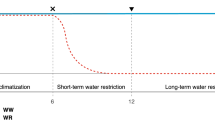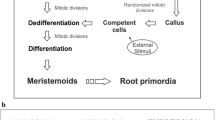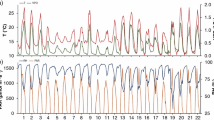Abstract
Adventitious rooting is a complex developmental response affected by genetic and environmental factors. Radiation quality effects on adventitious rooting depend on characteristics such as species, growth stage, irradiance, spectral quality, and time of exposure. Eucalyptus is an essential genus for the paper industry, and high yield plantations depend on adventitious rooting of selected genotypes. This work addressed two hypotheses: (1) radiation quality equally affects adventitious rooting in Eucalyptus species of different recalcitrance; (2) adventitious rooting outcome depends on both donor plant and cutting radiation quality treatments. To that end, the easy-to-root Eucalyptus grandis and the recalcitrant Eucalyptus globulus were evaluated. The effect of white, blue, red and far-red radiation enrichment on microcuttings and donor plants of both species was evaluated in relation to rooting. There was no effect of radiation quality on adventitious rooting of E. grandis or when radiation treatments were applied to E. globulus microcuttings. In contrast, donor plants of E. globulus, grown in medium devoid of sucrose and exposed to far-red radiation, yielded microcuttings showing higher rooting percentage, even in the absence of exogenous auxin in the rooting medium. Sucrose in donor plant medium abolished the positive effect of far-red radiation. An increase in endogenous soluble sugars and starch contents in basal microcuttings was associated with far-red radiation treatment of donor plants. These results underline the importance of appropriate carbohydrate partitioning in donor plants for adventitious rooting of cuttings and provide a basis for understanding and overcoming rooting recalcitrance in E. globulus clones.





Similar content being viewed by others
References
Agulló-Antón MA, Sánchez-Bravo J, Acosta M, Druege U (2011) Auxins or sugars: what makes the difference in the adventitious rooting of stored carnation cuttings? J Plant Growth Regul 30:100–113
Ahkami AH, Lischewski S, Haensch KT, Porfirova S, Hofmann J, Rolletschek H, Melzer M, Franken P, Hause B, Druege U, Hajirezaei MR (2009) Molecular physiology of adventitious root formation in Petunia hybrida cuttings: involvement of wound response and primary metabolism. New Phytol 181:613–625
Altamura MM, Falasca G (2009) Adventitious rooting in model plants and in vitro systems: An integrated molecular and cytohistological approach. In: Niemi K, Scagel C (eds) Adventitious root formation of forest trees and horticultural plants—from genes to applications. Research Signpost, Kerala, pp 123–144
Antonopoulou C, Dimassi K, Therios I, Chatzissavvidis C (2004) The influence of radiation quality on in vitro rooting and nutrient concentrations of peach rootstock. Biol Plant 48:549–553
Baque MA, Hahn E-J, Paek K-Y (2010) Induction mechanism of adventitious roots from leaf explants of Morinda citrifolia as affected by auxin and light quality. In Vitro Cell Dev Biol-Plant 46:71–80
Baraldi R, Rossi F, Lercari B (1988) In vitro shoot development of Prunus GF 655–2: interaction between light and benzyladenine. Physiol Plant 74:440–443
Bison O, Ramalho MAP, Rezende GDSP, Aguiar AM, Resende MDV (2007) Combining ability of elite clones of Eucalyptus grandis and Eucalyptus urophylla with Eucalyptus globulus. Genet Mol Biol 30:417–422
Brown DE, Rashotte AM, Murphy AS, Normanly J, Tague BW, Peer WA, Taiz L, Muday GK (2001) Flavonoids act as negative regulators of auxin transport in vivo in Arabidopsis. Plant Physiol 126:524–535
Calamar A, De Klerk GJ (2002) Effect of sucrose on adventitious root regeneration in apple. Plant Cell Tissue Org 70:207–212
Canettieri EV, Rocha GJM, Carvalho JC, Silva BA (2007) Optimization of acid hydrolysis from the hemicellulosic fraction of Eucalyptus grandis residue using response surface methodology. Bioresour Technol 98:422–428
Chée R, Pool RM (1989) Morphogenic responses to propagule trimming, spectral irradiance and photoperiod of grapevine shoots recultured in vitro. J Am Soc Hortic Sci 114:350–354
Chiang V (2002) From rags to riches. Nat Biotechnol 20:557–558
Corrêa LR, Paim DC, Schwambach J, Fett-Neto AG (2005) Carbohydrates as regulatory factors on the rooting of Eucalyptus saligna Smith and Eucalyptus globulus Labill. Plant Growth Regul 45:63–73
De Klerk GJ (2002) Rooting of microcuttings: theory and practice. In Vitro Cell Dev-Pl 38:415–422
De Klerk GJ, Van Der Krieken W, De Jong JC (1999) The formation of adventitious roots: new concepts, new possibilities. In Vitro Cell Dev-Pl 35:189–199
Druege U (2009) Involvement of carbohydrates in survival and adventitious root formation of cuttings within the scope of global horticulture. In: Niemi K, Scagel C (eds) Adventitious root formation of forest trees and horticultural plants—from genes to applications. Research Signpost, Kerala, pp 187–208
Dubois M, Gilles KA, Hamilton JK, Rebers PA, Smith F (1956) Colorimetric method for determination of sugars and related substances. Anal Chem 28:350–356
Eldridge K, Davidson J, Hardwood C, Van Wyk G (1993) Eucalypt domestication and breeding. Oxford Science Publications, Oxford
Eliasson L (1971) Adverse effect of shoot growth on root growth in rooted cuttings of aspen. Physiol Plant 25:268–272
Fett-Neto AG, Fett JP, Goulart LWV, Pasquali G, Termignoni RR, Ferreira AG (2001) Distinct effects of auxin and light on adventitious root development in Eucalyptus saligna and Eucalyptus globulus. Tree Physiol 21:457–464
Fogaça CM, Fett-Neto AG (2005) Role of auxin and its modulators in the adventitious rooting of Eucalyptus species differing in recalcitrance. Plant Growth Regul 45:1–10
Franklin KA, Quail PH (2010) Phytochrome functions in Arabidopsis development. J Exp Bot 61:11–24
Friend AL, Coleman MD, Isebrands JG (1994) Carbon allocation to root and shoot systems of woody plants. In: Davis TD, Haissig BE (eds) Biology of adventitious root formation. Plenum Press, New York, pp 245–274
Fuernkranz HA, Nowak CA, Maynard CA (1990) Light effects on in vitro adventitious root formation in axillary shoots of mature Prunus serotina. Physiol Plant 48:629–631
Haissig BE (1984) Carbohydrate accumulation and partitioning in Pinus banksiana seedlings and seedling cuttings. Physiol Plant 61:13–19
Hall MB (2003) Challenges with nonfiber carbohydrate methods. J Anim Sci 81:3226–3232
Hansen J, Strömquist L-H, Ericsson A (1978) Influence of the irradiance on carbohydrate content and rooting of cuttings of Pine seedlings (Pinus sylvestris L.). Plant Physiol 61:975–979
Héraut-Bron V, Robin C, Varlet-Grancher C, Guckert A (2001) Phytochrome mediates effects on leaves of white clover: consequences for light interception by the plant under competition for light. Ann Bot 88:737–743
Hoad SP, Leakey RRB (1996) Effects of pre-severance light quality on the vegetative propagation of Eucalyptus grandis W. Hill ex Maiden—Cutting morphology, gas exchange and carbohydrate status during rooting. Trees 10:317–324
Jensen PJ, Hangarter RP, Estelle M (1998) Auxin transport is required for hypocotyl elongation in light-grow but not dark-grow Arabidopsis. Plant Physiol 116:455–462
Klopotek Y, Haensch KT, Hause B, Hajirezaei M-R, Druege U (2010) Dark exposure of petunia cuttings strongly improves adventitious root formation and enhances carbohydrate availability during rooting in the light. J Plant Physiol 167:547–554
Le Roux JJ, Van Staden J (1991) Micropropagation and tissue culture of Eucalyptus—a review. Tree Physiol 9:435–477
Leakey RRB, Storeton-West R (1992) The rooting ability of Triplochiton scleroxylon cuttings: the interactions between stockplant irradiance, light quality and nutrients. For Ecol Manag 49:133–150
Lin B-L, Yang W-J (1999) Blue light and abscisic acid independently induce heterophyllous switch in Marsilea quadrifolia. Plant Physiol 119:429–434
Macedo AF, Leal-Costa MV, Tavares ES, Lage CLS, Esquibel MA (2011) The effect of light quality on leaf production and development of in vitro cultured plants of Alternanthera brasiliana Kuntze. Environ Exp Bot 70:43–50
McCready RM, Guggolz J, Silveira V, Owens HS (1950) Determination of starch and amylase in vegetables. Anal Chem 22:1156–1158
Mishra BS, Singh M, Aggrawal P, Laxmi A (2009) Glucose and auxin signaling interaction in controlling Arabidopsis thaliana seedlings root growth and development. PLoS ONE 4: e-4502
Moe R, Andersen AS (1988) Stockplant environment and subsequent adventitious rooting. In: Davis TD, Hassig BE, Sankhla N (eds) Adventitious root formation in cuttings—advances in plant science series, vol 2. Dioscorides Press, Portland, pp 214–234
Möller SG, Ingles PJ, Whitelam GC (2002) The cell biology of phytochrome signaling. N Phytol 154:553–590
Montgomery BL, Lagarias JC (2002) Phytochrome ancestry: sensors of biling and light. Trends Plant Sci 7:399–404
Mora AL, Garcia CH (2000) A Cultura do eucalipto no brasil (in Portuguese). SBS, São Paulo
Morelli G, Ruberti I (2002) Light and shade in the photocontrol of Arabidopsis growth. Trends Plant Sci 7:399–404
Murashige T, Skoog F (1962) A revised medium for rapid growth and bioassay with tobacco tissue culture. Physiol Plant 15:473–497
Murphy A, Peer WA, Taiz L (2000) Regulation of auxin transport by aminopeptidases and endogenous flavonoids. Planta 211:315–324
Newton AC, Dick JM, McBeath C, Leakey RRB (1996) The influence of R:FR ratio on growth, photosynthesis and rooting ability of Terminalia spinosa Engl. And Triplochiton scleroxylon K. Schum. Ann Appl Biol 128:541–556
Pawlicki N, Welander M (1995) Influence of carbohydrate source, auxin concentration and time of exposure on adventitious rooting of the apple rootstock Jork 9. Plant Sci 106:167–176
Peer WA, Murphy AS (2007) Flavonoids and auxin transport: modulators or regulators? Trends Plant Sci 12:556–563
Quattrocchio F, Baudry A, Lepiniec L, Grotewold E (2006) The regulation of flavonoids biosynthesis. In: Grotewold E (ed) The science of flavonoids. Springer, New York, pp 97–122
Rapaka VK, Bessler B, Schreiner M, Druege U (2005) Interplay between initial carbohydrate availability, current photosynthesis and adventitious root formation in Pelargonium cuttings. Plant Sci 168:1547–1560
Reid D, Beall FD, Pharis RP (1991) Environmental cues in plant growth and development. In: Steward FC (ed) Plant physiology—a treatise, vol X. Academic Press, London, pp 65–181
Roland F, Sheen J (2005) Sugar sensing and signaling network in plants. Biochem Soc Trans 33:269–271
Roland F, Baena-Gonzalez E, Sheen J (2006) Sugar sensing and signaling in plants: conserved and novel mechanisms. Annu Rev Plant Biol 57:675–709
Ruedell CM, Schwambach J, Corrêa LR, Fett-Neto AG (2009) Strategies for adventitious rooting in clonal propagation of Eucalyptus. In: Niemi K, Scagel C (eds) Adventitious root formation of forest trees and horticultural plants—from genes to applications. Research Signpost, Kerala, pp 337–358
Saebo A, Skjeseth G, Appelgren M (1995) Light quality of in vitro stage affects subsequent rooting and field performance of Betula pendula (Roth). Scand J For Res 10:155–160
Schwambach J, Fadanelli C, Fett-Neto AG (2005) Mineral nutrition and adventitious rooting in microcuttings of Eucalyptus globulus. Tree Phys 25:487–494
Schwambach J, Ruedell CM, Almeida MR, Penchel Filho RM, Araújo EF, Fett-Neto AG (2008) Adventitious rooting of Eucalyptus globulus × maidenii minicuttings derived from mini-stumps grown in sand bed and intermittent flooding trays: a comparative study. N For 36:261–271
Serrano L, Rochange F, Semblant JP, Marque C, Teulières C, Boudet AM (1996) Genetic transformation of Eucalyptus globulus trought biolistics: complementary development of procedures for organogenesis from zygotic embryos and stable transformation of corresponding proliferating tissue. J Exp Bot 45:285–290
Stowe-Evans EL, Luesse DR, Liscum E (2001) The enhancement of phototropininduced phototropic curvature in Arabidopsis occurs via a photoreversible phytochrome A-dependent modulation of auxin responsiveness. Plant Physiol 126:826–834
Takahashi F, Sato-Nara K, Kobayashi K, Suzuki M, Suzuki H (2003) Sugar induced adventitious root in Arabidopsis seedlings. J Plant Res 116:83–91
Turnbull JW (1999) Eucalypt plantations. New For 17:37–52
Tyburski J, Tretyn A (2004) The role of light and polar auxin transport in root regeneration from hypocotyls of tomato seedling cuttings. Plant Growth Regul 42:39–48
Wilson PJ (1998) Environmental preferences of Eucalyptus globulus stem cuttings in one nursery. N Zeal J For Sci 28:304–315
Zhishen J, Mengcheng T, Jianming W (1999) The determination of flavonoid contents in mulberry and their scavenging effects on superoxide radicals. Food Chem 64:555–559
Acknowledgments
Funding for this research was provided by the Brazilian Agencies National Council for Scientific and Technological Development (CNPq), National Committee for Improvement of Higher Level Education Personnel (CAPES) and Rio Grande do Sul State Foundation for Research Support (FAPERGS). A grant-in-aid-of-research from Fibria (former Aracruz) is also gratefully acknowledged.
Author information
Authors and Affiliations
Corresponding author
Rights and permissions
About this article
Cite this article
Ruedell, C.M., de Almeida, M.R., Schwambach, J. et al. Pre and post-severance effects of light quality on carbohydrate dynamics and microcutting adventitious rooting of two Eucalyptus species of contrasting recalcitrance. Plant Growth Regul 69, 235–245 (2013). https://doi.org/10.1007/s10725-012-9766-3
Received:
Accepted:
Published:
Issue Date:
DOI: https://doi.org/10.1007/s10725-012-9766-3




